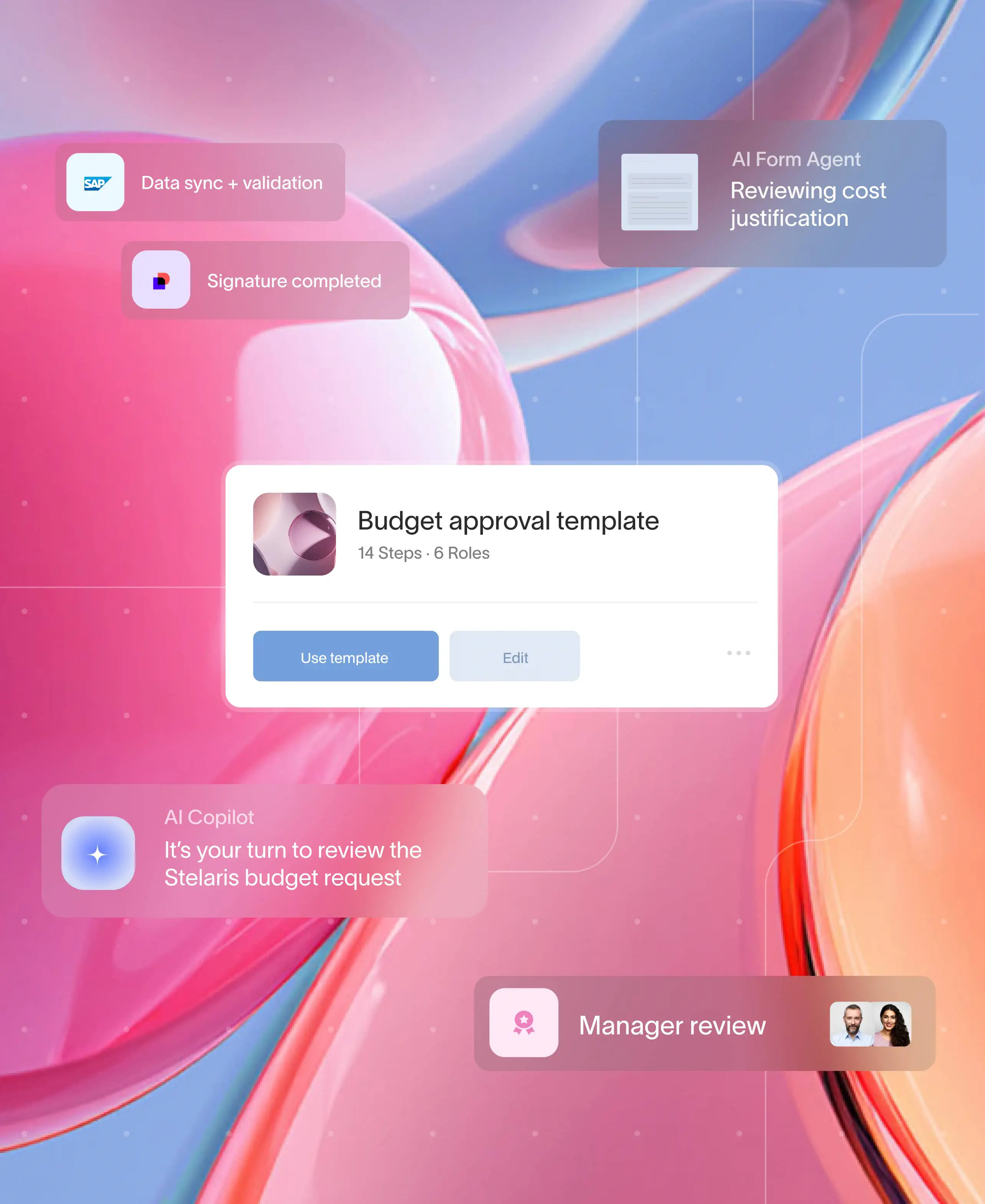.webp)
At a glance
- Email and generic file sharing create security gaps, version chaos, and audit headaches, especially in regulated industries where mistakes are costly.
- A secure, branded client portal that centralizes documents, approvals, messaging, and audit logs with AES-256 encryption, SOC 2 Type II controls, granular RBAC, and immutable activity trails.
- A clear feature roadmap across security and compliance, workflow automation, client experience and branding, file management, integrations and APIs, analytics, and templates so you can evaluate vendors and run a live proof with your own workflows.
- Moxo combines enterprise security, white-label portals, visual workflow automation, agentic AI, and proven integrations to replace email attachments with controlled, trackable processes that speed onboarding and approvals. The smart move is to standardize on a portal that fits your industry and stack.
The email apocalypse costs businesses millions daily
Picture this: Your lawyer is chasing signed agreements across three different email threads. Your wealth manager is piecing together KYC documents scattered throughout clients' inboxes. Your consultant just missed an audit deadline because approvals got lost in spam folders.
Sound familiar? You're not alone.
For regulated data, email is risky and slow. The fix is a structured document collection portal that centralizes files, approvals, messaging, and audit logs while reducing exposure.
The client file sharing portal market is exploding for good reason, growing from $1.7 billion in 2023 to a projected $7.95 billion by 2032. Smart businesses are abandoning email chaos for centralized, secure portals that work.
In this article, you will learn exactly which client file-sharing portal features protect your business while delighting your clients. This comprehensive guide covers security frameworks, workflow automation capabilities, and industry-specific requirements.
Essential features checklist for client file sharing portals
Use this comprehensive checklist to evaluate every potential client portal solution. Each feature directly impacts security, efficiency, and client satisfaction.
While this checklist covers essential features, dive deeper into the best client portal software features to understand how leading platforms implement these capabilities.
Security & compliance foundation
- End-to-end encryption (AES-256): Encrypt data in transit and at rest. Ask vendors to provide certificates and show how they encrypt and store fields in their databases.
- SOC 2 Type II (recent): Confirms ongoing controls, not just a point-in-time check. Request the full report, not a marketing badge.
- Granular role-based access (RBAC): Partners, associates, clients, and vendors should only see what they need. In the demo, restrict a document to one person and revoke access instantly.
- Immutable audit trails: Every view, upload, comment, and approval should be time-stamped and non-editable. Confirm exportability for audits and court use.
Workflow automation capabilities
- Visual workflow builder: Non-technical users should drag-and-drop steps and conditional logic. Ask to build a multi-step approval process during the demo.
- Template library: Start fast with industry templates (e.g., KYC, matter intake, loan packages). Count how many apply to your use cases.
- Automated routing & escalations: If an approver is OOO, the process must continue. Simulate absences to see rerouting and escalations.
- Intelligent notifications: Reduce noise, not visibility. Set rules by role, document type, and urgency. Test email, SMS, and in-app.
Client experience & branding
- Full white-label: Your domain, logo, colors, and tone. Avoid generic URLs, which weaken trust.
- Mobile-first: All critical actions, upload, annotate, e-sign, and approve – must work smoothly on phones.
- Zero-training navigation: Hand the demo to a newcomer. They should complete a task in minutes without instructions.
Integration & connectivity
- API-first: Review API docs, auth model, rate limits, and webhooks. Test a small integration with your CRM or DMS and confirm a realistic timeline.
- Pre-built connectors: Expect plug-and-play for staples like Salesforce, QuickBooks, and DocuSign. Validate data flow (one-way vs two-way), error handling, and field mapping.
Bottom line: Choose a portal that is secure by design, automates busywork, feels like your brand, and integrates seamlessly into your stack without requiring IT heavy lifting.
Industry-specific requirements
Different industries have different compliance rules, approval paths, and client expectations. Use the checklists below, then validate the fit in a live workflow demo with your own documents.
Financial services & accounting
- Must-haves: SOX-aligned controls, immutable audit trails, KYC/AML workflows with document validation, secure client messaging, and wealth/tax reporting templates.
- Why it matters: Regulators expect clear proof of who did what, and when. During tax season and year-end, portals cut email back-and-forth and prevent version chaos.
- What to test: Can you automate KYC steps, validate IDs and statements, and export audit logs on demand? Are reporting packs templatized and secure?
- Example: BNP Paribas cut onboarding time by 50% with automated client workflows and complete audit trails.
Legal
- Must-haves: Attorney–client privilege protection, granular access (by matter, role, and document), court-admissible chain of custody, trust accounting with IOLTA compliance, and conflict-check integration.
- Why it matters: One leak or misrouted file can compromise a case.
- What to test: Restrict a document to specific individuals, then revoke access. Generate an immutable activity report. Run a conflict check from the portal.
- Example: Veon Szu Law Firm increased workflow efficiency by 80% after moving to a centralized portal with automated updates and e-signatures.
Healthcare
- Must-haves: HIPAA compliance, encryption in transit/at rest, consent management, patient portal integration (EHR/EMR), and role-based privacy controls.
- Why it matters: Protect PHI without slowing clinical workflows.
- What to test: Capture consent, share records securely, and log access. Verify that clinicians and admin staff see different views.
- Example: ChenMed improved appointment follow-through by 27% using AI-assisted reminders and document handling inside a secure portal.
Real estate
- Must-haves: MLS integration, transaction coordination, e-signature flows for offers and purchase agreements, escrow collaboration, commission tracking, and closing checklists.
- Why it matters: Deals move fast; missing a step delays closings and payments.
- What to test: Build a transaction with milestones, route documents for e-sign, notify escrow, and generate a commission statement, end-to-end.
- Example: Savills reduced commercial deal cycle time by 40% by coordinating contracts and signings in a single portal.
Bottom line: Choose a portal that meets your industry’s rules, plugs into your systems, and proves it in a live demo with real workflows, not screenshots.
How Moxo delivers on every essential feature
Moxo unifies security, automation, branding, AI, and integrations in a single client portal. Here's how high-touch teams cover each essential requirement.
Enterprise-grade security by design
Moxo's file sharing portal for clients uses SOC 2 Type II controls and AES-256 encryption to protect data in transit and at rest. Financial institutions such as Citibank rely on this foundation for automated KYC, complete audit trails, and zero email leaks.
Workflow automation without the learning curve
The workflow builder lets non-technical teams create multi-step approvals, parallel reviews, and conditional routing. Pre-built workflows for finance, legal, real estate, healthcare, and consulting help you launch quickly, then tailor as you go.
White-label, end-to-end
Your domain, logo, colors, and voice carry through portals, emails, and mobile apps. Every interaction feels like your brand, not a generic third party.
Agentic AI that keeps work moving
Moxo AI reviews forms, validates documents, answers common questions, and sends smart reminders. Clients stay on track automatically while your team spends less time chasing files.
Integrations that integrate
A proven API and pre-built connectors tie the portal into your CRM, document management, e-signature, and financial systems. This reduces swivel-chair work and eliminates data silos.
Transform your client file sharing today
Email chaos does not define professional client relationships anymore. The right portal solution transforms scattered communications into streamlined, secure experiences that clients love and regulators approve.
Ready to see how leading firms revolutionize client engagement through intelligent automation?
Book a demo to discover how Moxo eliminates email headaches while boosting client satisfaction and operational efficiency.
FAQs
How quickly can we implement a client file-sharing portal?
With pre-built templates, basic setup takes minutes. Full customization typically takes 2 to 4 weeks for mid-market teams and 6 to 8 weeks for larger enterprise rollouts, depending on scope.
What makes client portals different from Dropbox or Google Drive?
Portals pair secure file sharing with branded workflows, automation, audit trails, and compliance controls. General file-sharing tools do not provide the process guidance, approvals, or enterprise security needed for professional engagements.
How do we ensure client adoption?
Prioritize simple navigation, passwordless entry, and clear next steps. Use automated reminders and a branded experience via private label and interaction features in the product suite.
Which integrations should we prioritize first?
Start with your CRM and core systems through product integrations. Add document systems, e-signature, and finance tools from the integrations catalog.





